How to Mirror an Android Phone to a TV
Gathering people around to show off something on your relatively small phone screen can be a pain, but thanks to screen mirroring, it doesn't have to be. We'll show you how to easily cast your Android phone or tablet to a much larger screen: your TV.
What Is Screen Mirroring?
Screen mirroring—also known as screen sharing or screen casting—is the act of displaying a live view of your phone's screen onto an external display (usually a TV). Everything you do on the phone is shown on the TV in real-time.
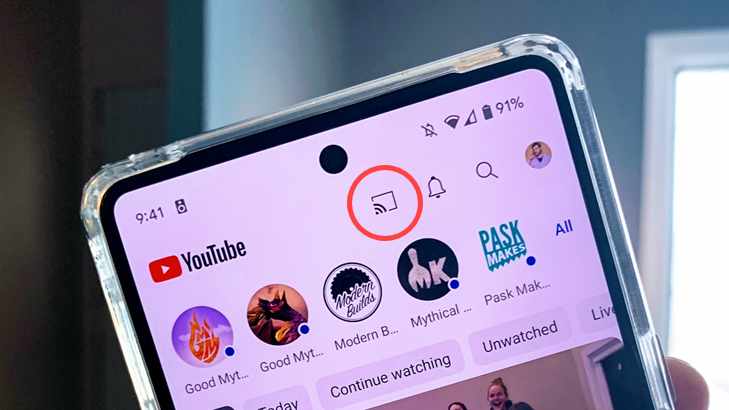
"Casting" your screen is usually the same as screen mirroring, but "casting" can also mean more than just screen mirroring. Many video and photo apps feature a cast button (shown above). This will cast a special version of the app to your TV screen, which is a much nicer experience than mirroring your screen.
Whether you call it "mirroring" or "casting," the goal is to show something from your phone on a larger screen. That's what we'll be accomplishing in this guide.
How to Cast Android to TV
To "cast" your Android phone screen, you'll need a TV with a Chromecast or a Chromecast-enabled streaming device, such as a Google TV stick. The first thing to do is open the Google Home app and long-press your TV to open it.

Next, tap the "Cast My Screen" shortcut from the bottom of the screen.

Tap "Cast Screen" on the pop-up dialog.
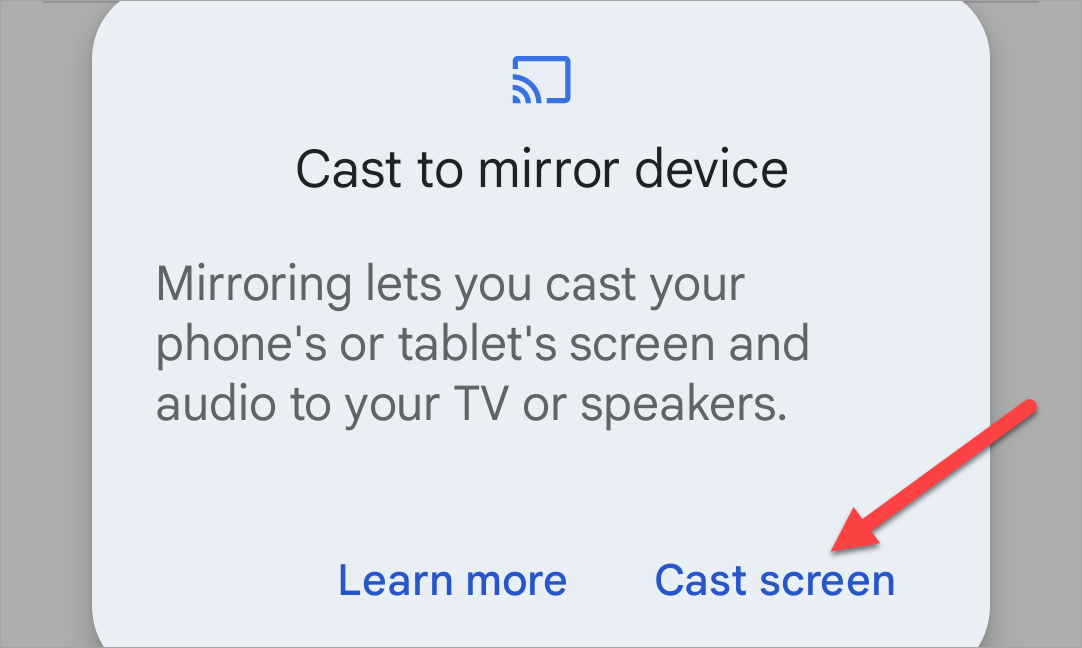
Depending on your phone, you may have the option to cast "A Single App" or the "Entire Display." Tap "Start Casting" when you're ready.
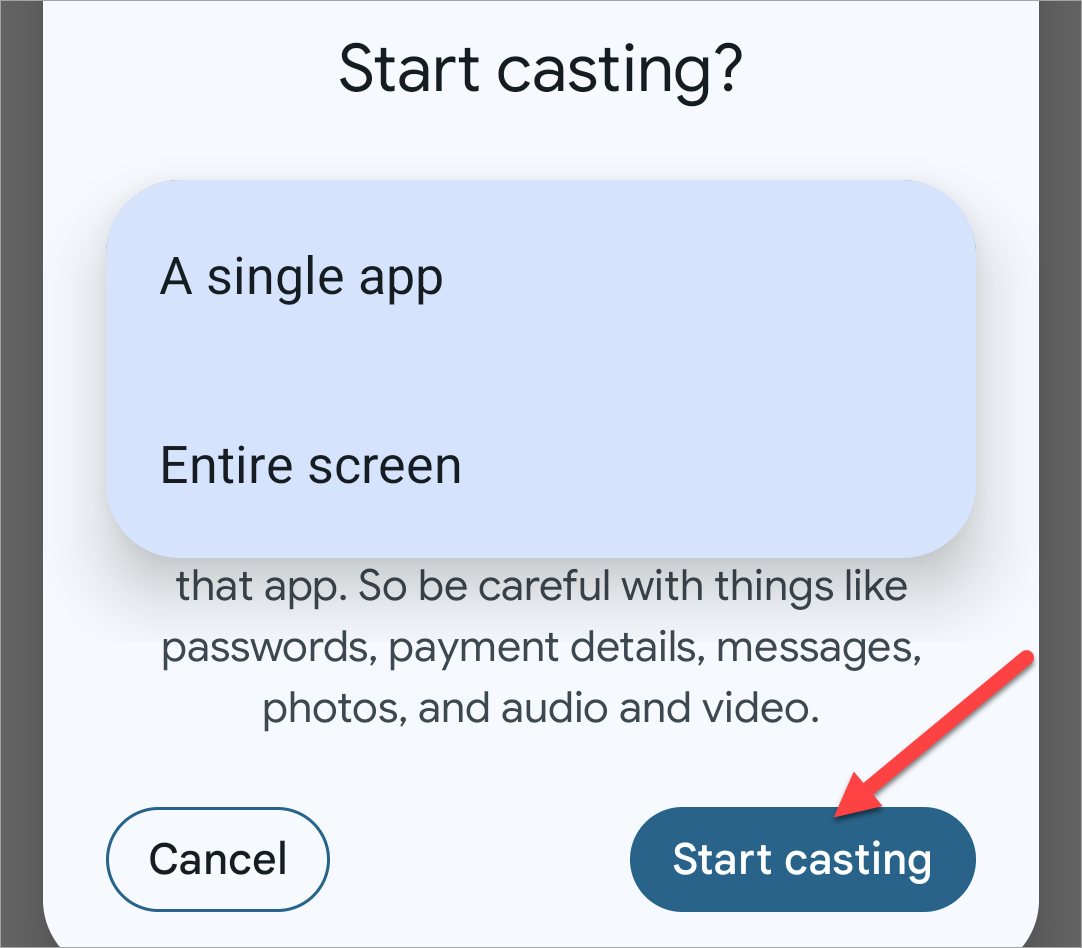
You should now see your phone screen on your TV!
To stop casting, you can tap the "Stop Mirroring" button from the Google Home app, or tap "Disconnect" from the notification.

That's all there is to it! You can also cast your screen in a similar way from Chrome or Edge on your PC or Mac. For Fire TV devices—which are also technically Android—you'll need slightly different steps.
How to Mirror Android to Roku
Mirroring an Android screen to Roku requires a device that supports Miracast. Most Android devices—with the exception of Google Pixel phones—support Miracast. It may be found under a number of different names:
- Smart View
- Quick Connect
- SmartShare
- AllShare Cast
- Wireless display
- Display mirroring
- HTC Connect
- Screen Casting
First, you need to make sure screen mirroring is enabled on the Roku. It should be enabled by default, but we can double-check by going to Settings > System > Screen Mirroring > Screen Mirroring Mode. You can choose to be prompted to allow screen mirroring every time or always allow it.

Next, it's a matter of finding your device's Miracast button in the Quick Settings menu. We'll be using a Samsung Galaxy device, which is called "Smart View." You may need to edit the Quick Settings panel to find the button.
Swipe down from the top of the screen once or twice—depending on your device—and select the Miracast button. In this case, it's labeled "Smart View."
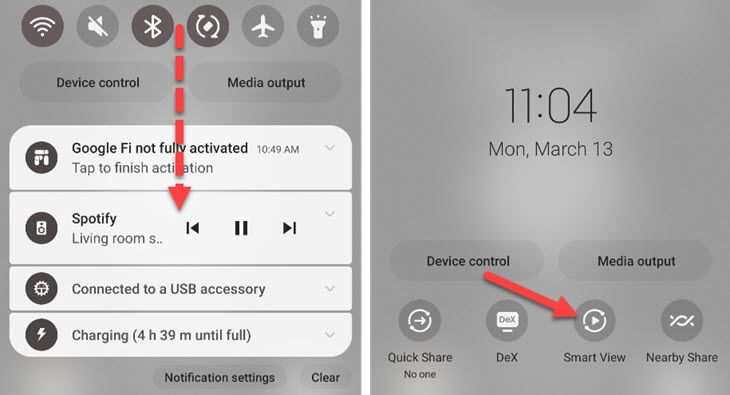
A menu will appear with devices connected to the same Wi-Fi network you're using. Select your Roku.
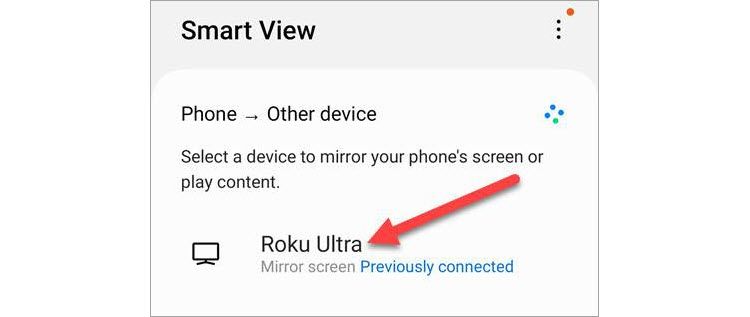
Tap "Start Now" on the confirmation pop-up.
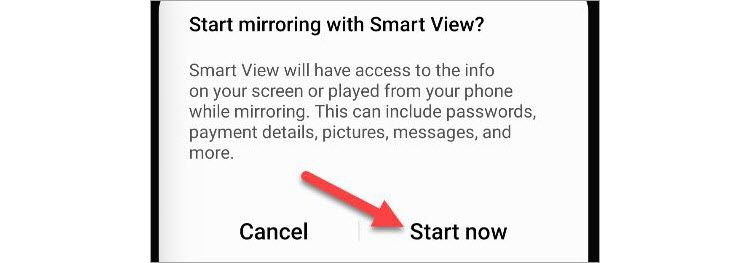
You'll now see your Android screen on the Roku! To stop screen mirroring, select the notification or floating button and tap "Disconnect."
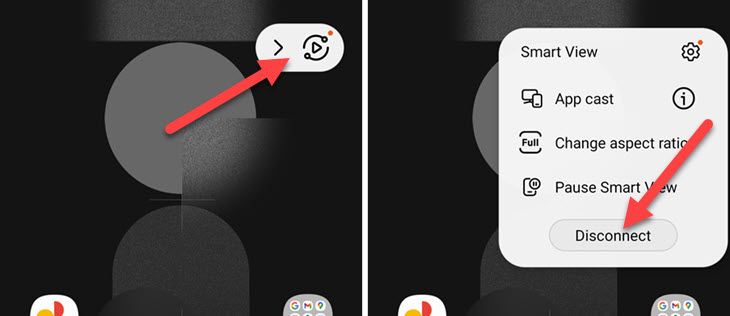
It's pretty easy to do if you have a device that supports Miracast. Thankfully, most Android devices do.
How to Mirror Android to Windows or Mac
The simplest way to mirror an Android device to a Windows or Mac PC is with an app called AirDroid. There's an AirDroid app for your Android device and a companion web app/desktop app for the PC. AirDroid has been around for a long time, and it works great.
First, install the "AirDroid Cast" app on your Android device. If you want to use the desktop app instead of the web app, install the Windows or Mac version on your PC as well.

Open the desktop app or navigate to webcast.airdroid.com in a web browser. Enter the nine-digit cast code in the Android app, then tap "Start Casting."

You'll be asked to accept a number of permissions. First, accept the connection of the device on your computer. Then enable the screen casting permission on your Android device and tap "Start Now" when asked about recording.

Your Android screen will be visible on your Windows or Mac PC! To end the screen mirroring, tap the "Disconnect" button on the PC.

That's all there is to it! AirDroid has a lot of other great features, too, but it's great to be able to easily cast to a computer without even signing into an account.
Screen mirroring isn't as difficult as it might seem if you have the right apps. It's an easy way to share your screen when you're trying to show something to multiple people. If you have an iPhone in your house, you can also cast your screen to a Roku, Fire TV, Windows PC, and Apple TV. Just make sure you have a good TV to mirror it to.
The above is the detailed content of How to Mirror an Android Phone to a TV. For more information, please follow other related articles on the PHP Chinese website!

Hot AI Tools

Undresser.AI Undress
AI-powered app for creating realistic nude photos

AI Clothes Remover
Online AI tool for removing clothes from photos.

Undress AI Tool
Undress images for free

Clothoff.io
AI clothes remover

Video Face Swap
Swap faces in any video effortlessly with our completely free AI face swap tool!

Hot Article

Hot Tools

Notepad++7.3.1
Easy-to-use and free code editor

SublimeText3 Chinese version
Chinese version, very easy to use

Zend Studio 13.0.1
Powerful PHP integrated development environment

Dreamweaver CS6
Visual web development tools

SublimeText3 Mac version
God-level code editing software (SublimeText3)

Hot Topics
 1662
1662
 14
14
 1418
1418
 52
52
 1311
1311
 25
25
 1261
1261
 29
29
 1234
1234
 24
24
 6 Best Gemini Features to Try on Your Google Pixel 9
Apr 15, 2025 am 01:09 AM
6 Best Gemini Features to Try on Your Google Pixel 9
Apr 15, 2025 am 01:09 AM
Unlock the Power of AI on Your Google Pixel 9: A Guide to Essential Features Google Pixel 9 users enjoy a suite of powerful AI-driven features. This guide highlights several, from photo enhancements to real-time translation. Let's explore what your
 Pixel 9a vs. Samsung Galaxy A56: Which Is the Better Deal?
Apr 15, 2025 am 03:02 AM
Pixel 9a vs. Samsung Galaxy A56: Which Is the Better Deal?
Apr 15, 2025 am 03:02 AM
Google Pixel 9a vs. Samsung Galaxy A56: A Detailed Comparison Google's Pixel 9a and Samsung's Galaxy A56 are strong contenders in the mid-range smartphone market, both boasting impressive features at a $499 starting price. However, the ideal choice
 You Don't Have to Choose Between iPhone and Android With the New Chipolo Pop Tracker
Apr 17, 2025 am 03:01 AM
You Don't Have to Choose Between iPhone and Android With the New Chipolo Pop Tracker
Apr 17, 2025 am 03:01 AM
Chipolo Pop Bluetooth Tracker Review: Taking into account both Apple and Android Losing your keys or wallet is a headache. Chipolo has been committed to helping users find lost items, and their latest product Pop is designed to meet the needs of both iPhone and Android users. It combines some of the best features of previous trackers to become a multi-functional device. If you have used Chipolo’s tracker before, you will notice that Pop has a similar colorful look as the previous Chipolo tracker. The key difference, however, is that it can work with both Apple's Find My Devices networks and Google's Find My Devices networks. Previously, you had to make a choice: iPhone users use Chi
 The Pixel 10 Camera Leak Has Me Excited (And Slightly Concerned)
Apr 15, 2025 am 12:56 AM
The Pixel 10 Camera Leak Has Me Excited (And Slightly Concerned)
Apr 15, 2025 am 12:56 AM
Pixel 10 Leaks: A Telephoto Lens, But at What Cost? The anticipation surrounding Pixel leaks is always exciting, especially given Google's knack for delivering impressive smartphone experiences—clean Android, seamless AI integration, and surprisingly
 Android 15 Says Goodbye to 16GB Phones
Apr 17, 2025 am 12:54 AM
Android 15 Says Goodbye to 16GB Phones
Apr 17, 2025 am 12:54 AM
Android devices with Google Play Store must now have at least 32GB of internal storage. This move aims to curb the issue of budget devices quickly running out of space. The updated Google Mobile Services (GMS) agreement mandates a minimum of 32GB int
 Samsung's Big Android 15 Update Is Finally Rolling Out
Apr 09, 2025 am 01:04 AM
Samsung's Big Android 15 Update Is Finally Rolling Out
Apr 09, 2025 am 01:04 AM
Samsung One UI 7 update officially launches! The Galaxy S24 series was the first to try it out, with the Z Fold 6 and Flip 6 following behind. This update brings major interface revisions, new control experiences and more Galaxy AI features. Official update schedule shows that the Galaxy S23 series and Tab S10 will receive updates in April, and other device updates will last until June. After a long wait, Samsung finally began to officially push the One UI 7 update based on Android 15, and the Galaxy S24 series became the first batch of beneficiary models. While this is exciting and it starts pushing on April 7 as scheduled, not all news is satisfying. After several months
 Samsung's One UI 7 Has Changed How I Feel About Default Android Launchers
Apr 08, 2025 am 12:59 AM
Samsung's One UI 7 Has Changed How I Feel About Default Android Launchers
Apr 08, 2025 am 12:59 AM
I've always used alternative launchers on my Android phones. But Samsung's One UI 7, now rolling out to Galaxy devices, is the first I actually love. Android's customizable home screen has always been a key draw, but One UI 7's attention to detail
 Plex Updates, the Pixel 9a, and a Whole Lot of Tariffs: Weekly Roundup
Apr 15, 2025 am 12:54 AM
Plex Updates, the Pixel 9a, and a Whole Lot of Tariffs: Weekly Roundup
Apr 15, 2025 am 12:54 AM
This week's tech headlines are packed with exciting news! From new phone releases and app updates to price hikes and software support changes, there's plenty to unpack. Here's a summary of the biggest stories you might have missed: Major Announcement




